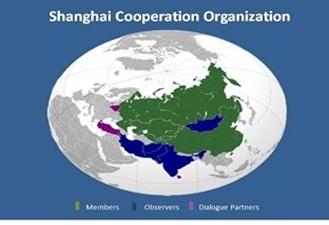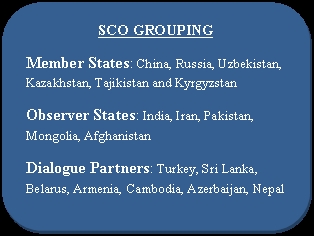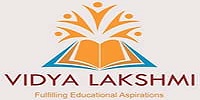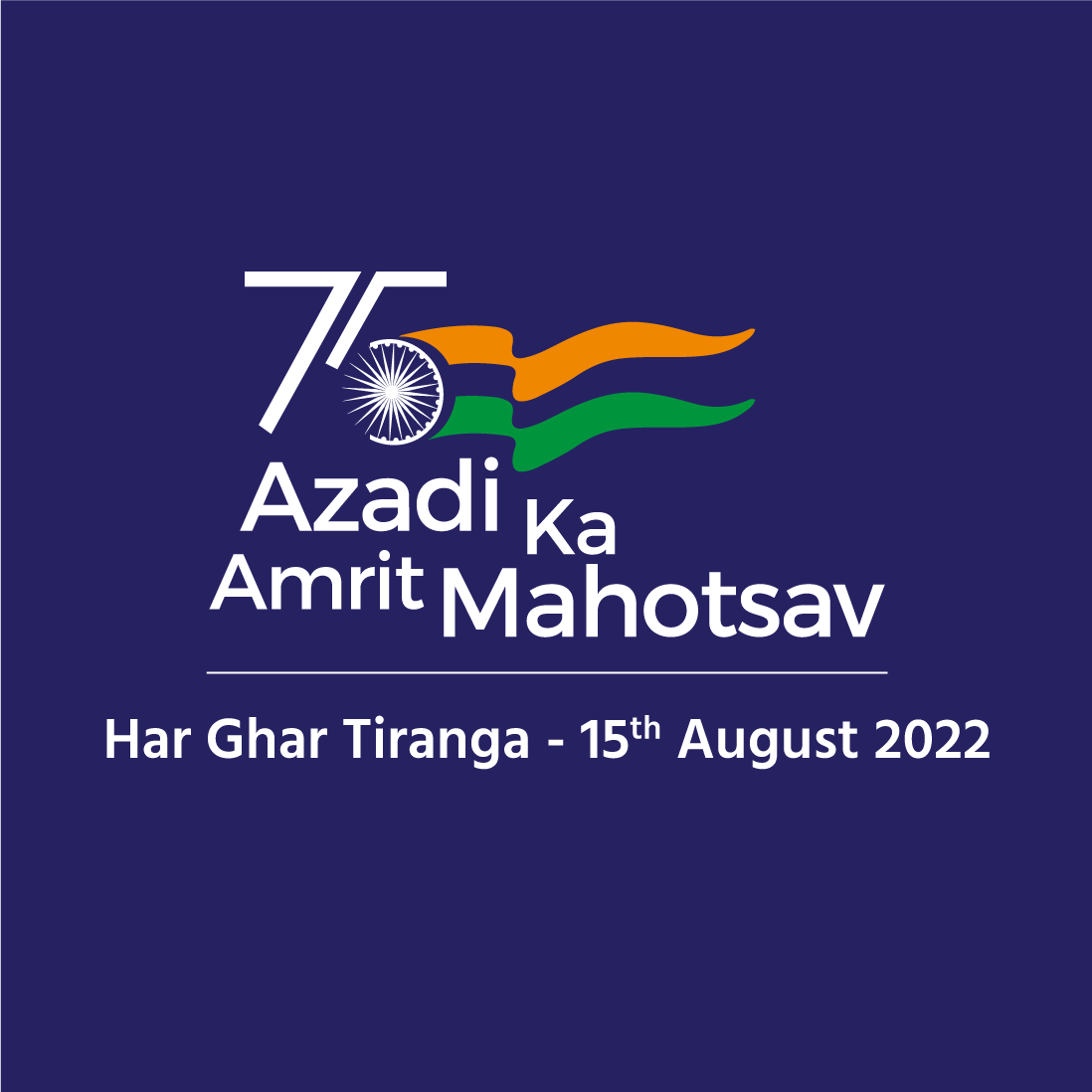
Indian Council of World Affairs
Sapru House, New DelhiIndia's SCO Membership: Prospects & Constraints
Introduction
The Shanghai Cooperation Organisation (SCO) was established in 2001 by China, Russia, Kazakhstan, Kyrgyzstan, Tajikistan and Uzbekistan to function as an inter-governmental platform for security and economic cooperation among its member states in the Eurasian region. India became SCO’s observer state in 2005. The first sign of India’s “readiness to enhance its engagement with the SCO”1 came in the year 2010 in the Tashkent Summit when its members “lifted the moratorium on new membership and paved the way for expansion of this regional grouping”2. However, the doubts on the “rules and procedures” for expansion of this (SCO) body”3 continued and it is only when “SCO finalized procedures for taking in new members”4 that India could submit its “formal application for the full membership of the SCO”5 in 2014.
India applied for full membership of SCO with various geostrategic, security and economic considerations. These considerations include “the evolving security situation in Afghanistan, capacity building in the central Asian region, connectivity with the Eurasian region, counter-terrorism and anti-narcotics, and energy cooperation.”6 SCO, as a platform for discussion, can elevate trust and cooperation between India and the other SCO members. Thus this regional organisation can help serve India’s geostrategic, security and economic interests in the Eurasian region better.
 |
 |
Source: Ministry of External Affairs, Government of India7,
However, in order to draw an inference on the prospects and constraints the SCO offers to India as a member, it is imperative to analyse the trajectory of SCO agenda till present (2016) and identify within it the Indian interests for joining SCO as a full member.
Trajectory of SCO Agenda
SCO originated in 2001 from Shanghai Five, a regional grouping constituted in 1996 to resolve boundary disputes between China, and former Soviet Republics, Kazakhstan, Kyrgyzstan and Tajikistan. In the initial years of its formation, between 2001 and 2005, SCO was preoccupied with building its basic institutions and expanding its external contacts base. In its 2001 agenda, for example, SCO referred to security issues like counteracting “terrorism, separatism and extremism”8 and “fight against illicit narcotics and arms trafficking,”9 but lacked the basic institutions to execute its plans. SCO’s first permanent institutions, the Secretariat and the Executive Committee of the Regional Anti-Terrorist Structure (RATS), came into existence in the year 2004. It also obtained observer status in the UN General Assembly in 2004. Mongolia became an observer state of SCO in the same year (2004). India, Pakistan, Iran joined SCO as observer states in 2005. Thus, building basic institutions and external contact base dominated in SCO’s agenda in the initial years of its formation.
Between 2005 and 2016, SCO agenda evolved to include multifaceted aspects. It addressed issues ranging from regional security threats to building greater economic, financial, connectivity and energy cooperation in the region. Some of the issues consistently emphasised in SCO agenda include non-interference in the internal matters of a country, counteracting the three evils, ‘terrorism, extremism and separatism’, support for stabilisation in Afghanistan and criticism of the use of force, militarily or sanctions as a measure for resolving dispute between two countries.
While consistently emphasising these issues, SCO agenda has evolved over time to become broad based. While 2005 Astana Summit of SCO focussed on “strengthening cooperation within the organization”10, by 2008 Dushanbe Summit its agenda expanded to include “joint anti-terror drills, on crackdown on the smuggling of arms, ammunition and explosives, and a memorandum on bank cooperation”11. The signing of an MoU (Memorandum of Understanding) between Interbank Association of SCO and the Eurasian Development Bank on partnership at the 2008 Dushanbe Summit was an indicator of SCO’s growing role in promoting regional economic cooperation.
From 2009, Yekaterinburg Summit of SCO, signs of seeking greater cooperation by SCO members in addressing regional security issues began to emerge as it is for the “first time that leaders from observer states - Mongolia, India, Pakistan and Iran - were included in a restricted meeting of the SCO Heads of State Council.”12 The growing concern in SCO over instability in Afghanistan was also emphasised on 27th March 2009, when a special conference on Afghanistan was organised in Moscow. The fact that SCO “lifted the moratorium on new membership and paved the way for expansion of this regional grouping”13 in its 2009 Summit, shows a continuation in SCO’s growing will to expand its member base and thereby receive greater cooperation in achieving its goals of security and economic cooperation. In its 2010 Summit Declaration SCO emphasised the need to “tackle international financial crisis, joint development projects on intra- and inter-regional transportation and communication infrastructure”14 along with approving “2011-2016 drug control strategy.”15 The Agenda in the 2011 SCO Summit included “regional security issues, combating drug trafficking, the situation in Afghanistan, and economic and humanitarian cooperation between the SCO member states.”16 The 2012 SCO Summit’s agenda called for “establishment of a nuclear-weapon-free zone in Central Asia.”17 In that Summit, Afghanistan became the observer state in SCO. In 2013 Summit SCO declared “unilateral sanctions unacceptable”18 in response to the sanctions imposed on the Iranian nuclear programme.
The broad spectrum of issues related to economic cooperation, energy demand, connectivity and security addressed between the 2014 and 2016 SCO Summits shows that along with security concerns economic considerations have begun dominating the SCO agenda. While the 2014 SCO joint communiqué emphasised on “expanding practical cooperation in finance, banking, science and technology, innovation, energy, including the use of alternative and renewable sources of energy, and customs, as well as in the field of agriculture, transport, telecommunications”19, the 2015 SCO Joint Communiqué stressed the need to counter “growing threats of terrorism and extremism, illegal drug trafficking and other forms of transnational organized crime” while working on the need of “practical implementation of the SCO Development Strategy 2025, the Program for Multilateral Cooperation in Trade and Economy of the SCO Member States and the Action Plan for its implementation, the List of Events for Further Development of Project Activities in the Framework of the SCO for 2012-2016.”20 Significantly, for the first time in this agenda SCO emphasised on the need for a plan of action to execute its goals. In its 2016 Agenda SCO reiterated the need for “Action Plan for 2016-2020 to implement the SCO's Development Strategy, which includes specific actions in the main cooperative areas such as political, security, economic, cultural, humanitarian, informational and international spheres.”21The recent emphasis on action plans in executing its Agenda indicates SCO’s realisation of the need to implement its goals at the ground level. It is essential to point here that apart from expanding its contact base and joint anti terrorism drills, the first such drill organised in 200222, in terms of achieving its Agendas SCO has not been very successful so far. The recent emphasis on action plan for executing its goals is a significant step ahead in this regard.
India’s Engagement with SCO: Mapping the Prospects
History of India’s engagement with the SCO goes back to the year 2005 when India joined this organisation as an observer state along with Pakistan and Iran. Between 2005, from observer status and 2010, the year India showed the interest for joining the SCO as a full member for the first time, India’s engagement with SCO had been limited, mainly due to India’s limited access to the SCO platform, as "observers do not participate in formulating decisions of the SCO institutions and do not bear responsibility for such decisions as well.”23 Under such restricted access to the platform as an observer India obviously had limited relation with SCO.
However, since 2010 there had been a gradual rise in India’s engagements with SCO. The then External Affair Minister, S. M. Krishna said in the Lok Sabha on 28 July 2010 that “SCO has grown rapidly in importance and is playing an important role in promoting stability, economic development and in combating terrorism in the Central Asian region as well as Afghanistan.”24
With the US announcement of its military drawdown in 2011 from Afghanistan, the significance of SCO as a stabilising factor in Afghanistan could have increased. However, the US has delayed drawing down of its army from Afghanistan to January 201725. Once the US withdraws from Afghanistan, India as a full member of SCO can play a greater role in its stabilising process.
Besides, economic, energy, connectivity and security interests are driving India towards SCO. It includes India’s objectives of “capacity building in the central Asian region, connectivity with the Eurasian region, counter-terrorism and anti-narcotics, and energy cooperation.”26 SCO agencies like SCO Business Council, RATS can help India in promoting these interests. In the 2011 Heads of State Summit Indian External Affairs Minister, S.M. Krishna, sums up these factors guiding India’s growing engagement with SCO. The Indian EAM pointed out: “We (India) are impressed that the SCO has taken several significant initiatives in recent years, especially in two major areas: in combating terrorism; and in the promotion of economic cooperation in the region.”27 On the similar line, in the 2013 Heads of State Summit of SCO EAM emphasised that “India has long been a victim of terrorism and we are acutely aware of the threat that its perpetrators pose to our people. We are of the firm view that only multilateral efforts and integrated actions can help effectively counter these negative forces including the related evils of drug trafficking and small arms proliferation.”28 An increase in Indian will to connect with Central Asia both for security and economic purposes becomes apparent through these statements.
Building on the same line of interest in the 2015 SCO Summit in Ufa, Prime Minister Narendra Modi emphasised that “we would lend our support to improving transportation and communication networks in the region. We can create a vast network of physical and digital connectivity that extends from Eurasia's northern corner to Asia's southern shores. The International North South Transportation Corridor (INSTC) is a step in that direction.”29 Connecting INSTC with other international networks can help the creation of an east west corridor for India, connecting it with Europe through land. In 2016 SCO Summit, PM Modi also pointed out that “India will be pleased to contribute to the development of infrastructure in the region. We will support efforts to create an environment that eases barriers and facilitates trade and investments in the region. India's requirement for energy and resources and its vast and dynamic market will boost prosperity in the SCO region. In turn, India will deepen its engagement in human resource development, information and communication technology, pharmaceuticals and health care, banking and capital markets, small and medium enterprises and micro finance, and food security and agriculture.”30 Thus, economic and financial gains are emerging as among the principal driving force in India’s joining the SCO.
Constraints in Achieving the Goals
However in achieving its economic and security interests in the Central Asian region through the SCO, India may face certain constraints. One of such factor is the dominant position of China in the SCO.
Another possible concern for India in the SCO could be the inclusion of Pakistan too with India as a full SCO member. Pakistan’s one point agenda of opposing India and seeking parity with it can vitiate the atmosphere in SCO. Moreover, China is Pakistan’s ‘all weather friend’ and Beijing supports Pakistan against India in South Asia to maintain the balance of power in South Asia. The recent lobbying of China in favour of Pakistan and linking it to India’s bid for membership of NSG (Nuclear Supplier Group)31, is indicative of the hurdles India may face at the strategic level in furthering its interest in the SCO.
Conclusion
Full membership in SCO offers India more prospects than constraints. Cooperation on security, energy, economic and connectivity issues is the prime gain India can expect as a full member of SCO. In the field of security, for example, SCO members are affected by the menace of terrorism, drug trafficking, small arms smuggling. SCO’s RATS mechanism can help evolve multipronged approach to deal with these threats. Article 7 of RATS, binds its signatories with the obligation of “actively developing cooperation to counteract terrorism, separatism and extremism; illegal trafficking in drugs, psychotropic substances and their precursors and arms; other forms of transnational criminal activity.”32
As part of SCO energy club, India can benefit from supply of energy from one of the world’s largest energy producing clubs. To note “the territory of the SCO member states holds about 25% of global oil reserves, over 50% of gas reserves, 35% of coal and about half of the world’s known uranium reserves. The biggest oil and gas pipelines have been laid or are being built here.” 33 It can help in achieving mutually beneficial long-term energy security for buyers and financial commitments for sellers.
Besides, in terms of connectivity and infrastructural prospects, if India works with other partner countries of the SCO in joining the INSTC project with other connectivity projects in the Eurasian region, for example China-led OBOR, another route from India to Europe can be made available for economic engagements. Though, India has shown reservations in joining OBOR so far, as Indian Foreign Secretary, Dr. Jaishankar explained “where we (India) stand is that if this is something on which they (China) want a larger buy in, then they need to have larger discussions, and those haven't happened."34 China’s emphasise on “opening free trade areas”35within the countries accepting OBOR is one such concern for India when India’s trade deficit with China has “increased to $ 44.7 billion between April January 2015-2016.”36 However India is a member country in Bangladesh-China-India-Myanmar (BCIM) Economic corridor which is “closely related to the Belt and Road Initiative”37 and as a founding member of AIIB (Asian Infrastructural Investment Bank), it is also working with China for infrastructural and connectivity projects in the Asian region.
In return, SCO also gains in various ways with India joining the group as a full member. India’s support to SCO’s commitment against three evils, terrorism, separatism and extremism, its energy demand and ability to assist SCO member country in their development, are some of the prospects India holds for SCO.
Thus, with India signing Memorandum of Obligation in the June 2016 SCO Summit held in Tashkent, Uzbekistan, it moved a step ahead in broadening its engagement with the organisation. As it signs “more than 30 other documents that are required to be acceded”38 and participates in the 2017 SCO summit in Kazakhstan, with veto power and access to all the rights and privileges as a full member of SCO, India will begin the journey of greater cooperation and connection between the South Asian and Eurasian region.
***
* The Authoress is a Research Intern at Indian Council of World Affairs, Sapru House, New Delhi.
Disclaimer: The views expressed are that of the Researcher and not of the Council.
Endnotes:
1 ‘Unstarred Question’ Q.675 Shanghai Cooperation Organisation, Lok Sabha, Ministry of External Affairs, Government of India, July 28, 2010, at http://www.mea.gov.in/lok-sabha.htm?dtl/16486/Q675+Shanghai+Cooperation+Organisation (accessed on 20 June 2016).
2 ‘SCO Summit, Bishkek (September 13, 2013), September 09, 2013, Ministry of External Affairs, Government of India, at http://www.mea.gov.in/in-focus-article.htm?22172/SCO+Summit+Bishkek+September+13+2013 (accessed on 17 June 2016).
3 Unstarred Question’ Q.675 Shanghai Cooperation Organisation, Lok Sabha, Ministry of External Affairs, Government of India, July 28, 2010, at http://www.mea.gov.in/lok-sabha.htm?dtl/16486/Q675+Shanghai+Cooperation+Organisation (accessed on 20 June 2016).
4 Shannon Tiezzi, “The New, Improved Shanghai Cooperation Organization” The Diplomat, September 13, 2014, at http://thediplomat.com/2014/09/the-new-improved-shanghai-cooperation-organization/ (accessed on 15 June 2014).
5 “Statement by External Affairs Minister at the Shanghai Cooperation Organization (SCO) Heads of State Summit 2014 in Dushanbe”, Ministry of External Affairs, Government of India, September 12, 2014, at http://www.mea.gov.in/Speeches-Statements.htm?dtl/23993/Statement+by+External+Affairs+Minister+at+the+Shanghai+Cooperation+Organization+SCO+Heads+of+State+Summit+2014+in+Dushanbe (accessed on 17 June 2016).
6 ‘SCO Summit, Bishkek (September 13, 2013), September 09, 2013, Ministry of External Affairs, Government of India, at http://mea.gov.in/in-focus-article.htm?22172/SCO+Summit+Bishkek+September+13+2013 (accessed on 17 June 2016).
7 “SCO Summit, Bishkek (September 13, 2013), Ministry of External Affairs, Government of India, at http://www.mea.gov.in/in-focus-topic.htm?103/SCO+Summit+Bishkek+September+13+2013 (accessed on 17 June 2016).
8Charter of the Shanghai Cooperation Organization, Signed in St. Petersburg on 7th June 2002.
9 Ibid
10 Backgrounder: A brief history of SCO Summits, Xinhuanet, 12 September 2014, at http://news.xinhuanet.com/english/china/2014-09/12/c_133639022.htm (accessed on 20 June 2016).
11 Ibid
12Ibid
13 ‘SCO Summit, Bishkek (September 13, 2013), September 09, 2013, Ministry of External Affairs, Government of India, at http://www.mea.gov.in/in-focus-article.htm?22172/SCO+Summit+Bishkek+September+13+2013 (accessed on 17 June 2016).
14“ Declaration of the 10th Meeting of The Council of Heads of State of the SCO Member States
Tashkent, 10-11 June 2010, Ministry of Foreign Affairs, the People's Republic of China, at http://www.fmprc.gov.cn/mfa_eng/zxxx_662805/t711709.shtml (accessed on 17 June 2016).
15Ibid
16 “Tenth anniversary Summit of Shanghai Cooperation Organisation” 15 June 2011, at http://en.kremlin.ru/events/president/news/11577 (accessed on 16 June 2016).
17 Backgrounder: A brief history of SCO Summits, Xinhuanet, 12 September 2014, at http://news.xinhuanet.com/english/china/2014-09/12/c_133639022.htm (accessed on 20 June 2016).
18 “SCO Summit issues declaration” China Daily, 13 September 2013 at http://www.chinadaily.com.cn/china/2013xivisitcenterasia/2013-09/13/content_16969449.htm (accessed on 19 June 2016).
19 Joint Communiqué of the results of 13th Meeting of the Council of Heads of Government (Prime Ministers) of the Shanghai Cooperation Organisation Member States, Official Website of Russia’s Presidency in the Shanghai Cooperation Organisation, 2014-2015 at en.sco-russia.ru/load/1013273717 (accessed on 17 June 2016).
20 “Full text of joint communique on outcomes of 14th SCO prime ministers” Xinhuanet,15 December 2015, at http://news.xinhuanet.com/english/china/2015-12/15/c_134920145.htm (accessed on 18 June 2016).
21 “Uzbek foreign ministry holds press conference about 16th SCO summit” Xinhuanet 21 June 2016 at http://news.xinhuanet.com/english/2016-06/21/c_135452025.htm (accessed on 23 June 2016).
22 “Backgrounder: SCO anti-terror military drills” Xinhuanet, 10 September 2010 at http://news.xinhuanet.com/english2010/world/2010-09/10/c_13489722.htm (accessed on 17 June 2016).
23 The Regulations on Observer Status at the Shanghai Cooperation Organisation, Article 14 of SCO Charter, Signed on 7th June 2002, Key Normative Documents of the Shanghai Cooperation Organization, Human Rights in China at http://www.hrichina.org/sites/default/files/PDFs/Reports/SCO/2011-HRIC-SCO-Whitepaper-AppendixA-SCO-Docs.pdf (accessed on 23 June 2016).
24 Unstarred Question’ Q.675 Shanghai Cooperation Organisation, Lok Sabha, Ministry of External Affairs, Government of India, July 28, 2010, at http://www.mea.gov.in/lok-sabha.htm?dtl/16486/Q675+Shanghai+Cooperation+Organisation (accessed on 20 June 2016).
25 “In Reversal, Obama Says U.S. Soldiers Will Stay in Afghanistan to 2017” The New York Times, 15 October 2015, at http://www.nytimes.com/2015/10/16/world/asia/obama-troop-withdrawal-afghanistan.html?_r=0 (accessed to 14 June 2016).
26 SCO Summit, Bishkek (September 13, 2013), 09 September 2013, Ministry of External Affairs, Government of India, at http://mea.gov.in/in-focus-article.htm?22172/SCO+Summit+Bishkek+September+13+2013 (accessed on 17 June 2016).
27 “Statement by EAM at the SCO Heads of States Summit” 15 June 2011, Ministry of External Affairs, Government of India at http://mea.gov.in/Speeches-Statements.htm?dtl/373/Statement+by+EAM+at+the+SCO+Heads+of+States+Summit (accessed on 17 June 2016).
28 “Statement by External Affairs Minister at the Shanghai Cooperation Organization (SCO) Heads of State Summit 2013 in Bishkek” Ministry of External Affairs, Government of India, 13 September 2013 at http://www.mea.gov.in/in-focus-article.htm?22197/Statement+by+External+Affairs+Minister+at+the+Shanghai+Cooperation+Organization+SCO+Heads+of+State+Summit+2013+in+Bishkek (accessed on 15 June 2016).
29 Ibid
30“Remarks by Prime Minister at Plenary of the Shanghai Cooperation Organisation” Ministry of External Affairs, Government of India, 10 July, 2015, at http://www.mea.gov.in/Speeches-Statements.htm?dtl/25454/Remarks_by_Prime_Minister_at_Plenary_of_the_Shanghai_Cooperation_Organisation (accessed on 18 June 2016).
31 “China clarifies Pakistan NSG application stance” Xinhuanet, 23 may 2016, at http://news.xinhuanet.com/english/2016-05/23/c_135381838.htm (accessed on 17 June 2016).
32Treaty on Long-Term Good-Neighborliness, Friendship and Cooperation Between the Member States of the Shanghai Cooperation Organization, Key Normative Documents of the Shanghai Cooperation Organization, Human Rights in China at http://www.hrichina.org/sites/default/files/PDFs/Reports/SCO/2011-HRIC-SCO-Whitepaper-AppendixA-SCO-Docs.pdf (accessed on 23 June 2016).
33 “SCO Energy Club: structure ready for international interaction, not Shanghai Six’s elite club” InfoSCO portal at http://infoshos.ru/en/?idn=13913 (accessed on 27 June 2016).
34Kasturi, Charu Sudan, “India wrinkle on China silk - Jaishankar speaks out on absence of consultations” The Telegraph, 21 July 2015, at http://www.telegraphindia.com/1150721/jsp/frontpage/story_32798.jsp#.VzBfquSRpT0. (accessed on 20 March 2016).
35“Vision and Actions on Jointly Building Silk Road Economic Belt and 21st-Century Maritime Silk Road” National Development and Reform Commission, Ministry of Foreign Affairs, and Ministry of Commerce of the People's Republic of China, with State Council authorization, March 2015, at http://en.ndrc.gov.cn/newsrelease/201503/t20150330_669367.html (accessed on 7 July 2016).
36 “India –China Trade Deficit at $ 44.7 billion in April-January”, The Economic Times, 02 march 2016, at http://economictimes.indiatimes.com/news/economy/foreign-trade/india-china-trade-deficit-at-44-7-billion-in-april-january/articleshow/51223260.cms (accessed on 27 June 2016).
37“Vision and Actions on Jointly Building Silk Road Economic Belt and 21st-Century Maritime Silk Road” National Development and Reform Commission, Ministry of Foreign Affairs, and Ministry of Commerce of the People's Republic of China, with State Council authorization, March 2015, at http://en.ndrc.gov.cn/newsrelease/201503/t20150330_669367.html (accessed on 7 July 2016).
38“Transcript of Media Briefing by Secretary (West) on PM's forthcoming visit to Tashkent for SCO Summit” (June 22, 2016) Ministry of External Affairs, Government of India , 22 June 2016, at http://www.mea.gov.in/media-briefings.htm?dtl/26952/Transcript+of+Media+Briefing+by+Secretary+West+on+PMs+forthcoming+visit+to+Tashkent+for+SCO+Summit+June+22+2016 (accessed on 28 June 2016).















